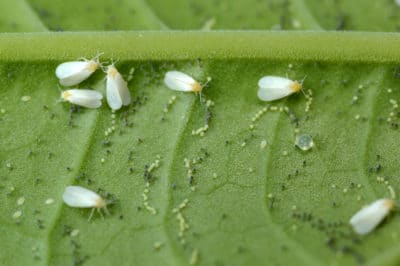Cucumber Beetles
Holes chewed in your cucumber’s leaves point to an infestation of striped or spotted, yellowish-green cucumber beetles. As carriers of bacterial wilt disease, these insects can decimate a cucumber crop. The tiny yellow eggs they deposit in soil cracks around the plants produce white, root-devouring grubs.
Pickleworms
If black-dotted green pickleworms find them first, your cukes may never see the inside of a pickle jar. The caterpillars chew tiny round holes in buds and flowers before burrowing into the fruit and leaving it inedible. Dark streaks of frass, or waste, may stain their feeding sites. The worms hatch from the eggs of night-flying moths.
Melon Aphids
Swarms of pear-shaped, deep-green or black melon aphids latch onto and drain the sap from cuke plants. You see brown, distorted foliage that eventually drops. Aphids also excrete syrupy waste that attracts ants and greasy, black sooty mold. The insects typically show up after the plants begin forming runners.
Whiteflies
Like melon aphids, silverleaf whiteflies consume huge quantities of cucumber sap and excrete it as sticky honeydew waste. Less than 1/16-inch long and covered in waxy, white powder, they feed and lay eggs on the backs of the leaves. Heavy infestations lead to dried-out, whitish to silvery leaves and unappetizing, sooty mold-covered fruit.
Thrips
Western flower thrips scrape and puncture cuke flowers and young shoots. Their feeding sites may have a silvery sheen; infested leaf edges often curl under. Only 1/25-inch long, the slender, yellow pests seldom do serious damage. Thrips threaten cucumbers early in the growing season. They also feed on harmful spider mites, so think twice about control measures.
Organic Cucumber Pest Control
Use these economical, eco-friendly methods to control cucumber pests:
- Floating row covers keep cucumber beetles, whiteflies, thrips and pickleworm moths off your young cucumbers while letting sunlight and moisture through. Leave them on 24/7; the moths lay eggs at night.
- Eliminate weeds, and the beetles and thrips are much less likely to visit.
- Reflective silver mulch around your seedlings repels whiteflies until the foliage becomes heavy enough to hide it.
- Kaolin clay solution dries to a sticky film that prevents cucumber beetles from feeding.
- Insecticidal soap spray kills aphids, thrips and whiteflies without leaving harmful residue.
Managing cucumber pests without resorting to chemical sprays is one of the best things you can do for your environment, from your soil and water to the beneficial insects and wild creatures that visit your garden — and most importantly, for the family and friends who share in your harvest!
